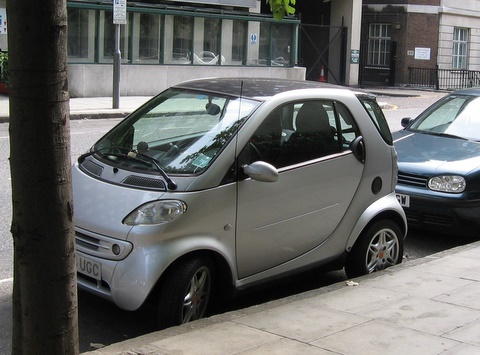Think globally, act locally. That’s the message of this Common Dreams article, entitled “Energy-Addicted US Can Learn a Lot From Europe.” And yes, we can really learn a lot about energy from Europeans.
Someday soon, we’re going to be having fantasies that we had their fleet of tiny cars, those same cars we laughed at a couple years ago. Cars that look like this one I photographed in London three years ago:
The huge U.S. fleet of gas-guzzling SUVs is putting us in a straight-jacket. Actually, it’s even worse. It’s a national security issue.
And what can you say about a government that allowed us to accumulate a fleet of oversized cars that we can’t afford to use? A fleet that causes us to act belligerently across the globe in an attempt to fill our huge cars with fuel? If only, 5 or 10 or 20 years ago, we had used the tiny amount of IQ necessary to see this energy crisis coming, so that we would have downsized our energy-using equipment in order to be prepared for what we’re about to face.



Thanks for continuing to beat this drum. Europe has made plenty of wise decisions beyond small cars, however, which give them advantages over us. In particular, they kept their dense, walkable city centers intact (whereas we gutted our city centers and small towns and replaced them with suburban sprawl that mandated lots of driving), and they invested heavily in rail transit such as bullet trains and streetcars. Our lack of city-to-city bullet trains will become especially painful as airlines collapse.
These wise decisions, in addition to their smaller cars, make Europe much more resilient to and oil crisis than the US.
Europe has been paying high fuel prices for a long time. I agree with Dan that a large part of the problem is the urban sprawl, but a lot of that is due to local zoning boards and political influence.
Nashville decided to allow multi-residential developement in the downtown area, and that helps the bankers, stockbrokers and lawyers that work in the downtown area, but the needs of the politically invisible majority (those people not wealthy enough to be considered politically important, but not poor enough to be considered in need of relief) are mostly left unaddressed.
So those that want to live downtown and can afford the high-priced condos and high-rent apartments can, but the clerks, hotel workers can't and I often see people wearing the uniforms of downtown hotel staff walking three or four miles in all type of weather to get home to the apartment complexes off the bus routes.
Good point, Niklaus. I am a city planner who specalizes in the revitalization of downtowns, and affordable housing is a real challenge. It is a huge problem for downtowns to be abandoned by everyone but the poor, but when the wealthy return room must be left for everyone else, too. There are tools for doing this, but it takes a big commitment on the part of the city government. And it is important for the design to be attractive, for the low income housing to be spread around the district, and for the scale of individual projects to be small — we don't want to repeat the mistakes of urban renewal projects like Cabrini Green and Prewitt Igoe.
Another important challenge is to retrofit the suburbs to be more walkable and supportive of transit. This is a much tougher underraking, but if vehicle miles travelled continues to grow at three times the rate of population growth, we will erradicate important gains made by technological advances. Suburbia in its current form makes VMT reductions all but inpossible. Luckily, half of all buildings standing in the year 2040 do not yet exist. If we build all of this new stuff properly, we might make it out of this okay.